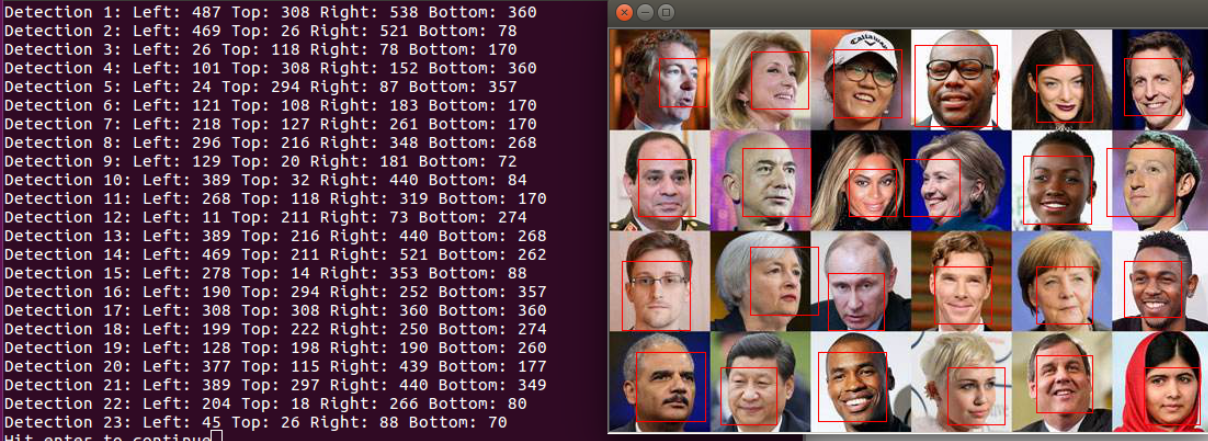Windows版本Dlib配置链接: 地址
1.准备工作
Dlib库下载链接: 地址
首先需要Cmake以及编译C++成python程序的工具【参考1】
sudo apt-get install libboost-python-dev cmake
如果没有setuptools工具的需要安装,指令如下:
python2.x:
wget https://bootstrap.pypa.io/ez_setup.py -O - | sudo python
python3.x
wget https://bootstrap.pypa.io/ez_setup.py -O - | sudo python3.42.安装dlib
接着cd到Dlib的目录运行,参考:地址
运行:(如果提示没权限记得 sudo su)
python setup.py install3.测试
python
import dlib
4.运行人脸检测
下面来运行经典的Dlib的landmark~
先安装下pip,参考链接:地址
sudo apt-get install python-pip python-dev build-essential
sudo pip install --upgrade pip
sudo pip install --upgrade virtualenv 然后安装skimage.io模块,参考: 地址
sudo pip install scikit-imagesudo apt-get install python-skimage人脸检测
新建fr.py
#!/usr/bin/python
# The contents of this file are in the public domain. See LICENSE_FOR_EXAMPLE_PROGRAMS.txt
#
# This example program shows how to find frontal human faces in an image. In
# particular, it shows how you can take a list of images from the command
# line and display each on the screen with red boxes overlaid on each human
# face.
#
# The examples/faces folder contains some jpg images of people. You can run
# this program on them and see the detections by executing the
# following command:
# ./face_detector.py ../examples/faces/*.jpg
#
# This face detector is made using the now classic Histogram of Oriented
# Gradients (HOG) feature combined with a linear classifier, an image
# pyramid, and sliding window detection scheme. This type of object detector
# is fairly general and capable of detecting many types of semi-rigid objects
# in addition to human faces. Therefore, if you are interested in making
# your own object detectors then read the train_object_detector.py example
# program.
#
#
# COMPILING/INSTALLING THE DLIB PYTHON INTERFACE
# You can install dlib using the command:
# pip install dlib
#
# Alternatively, if you want to compile dlib yourself then go into the dlib
# root folder and run:
# python setup.py install
# or
# python setup.py install --yes USE_AVX_INSTRUCTIONS
# if you have a CPU that supports AVX instructions, since this makes some
# things run faster.
#
# Compiling dlib should work on any operating system so long as you have
# CMake and boost-python installed. On Ubuntu, this can be done easily by
# running the command:
# sudo apt-get install libboost-python-dev cmake
#
# Also note that this example requires scikit-image which can be installed
# via the command:
# pip install scikit-image
# Or downloaded from http://scikit-image.org/download.html.
import sys
import dlib
from skimage import io
detector = dlib.get_frontal_face_detector()
win = dlib.image_window()
for f in sys.argv[1:]:
print("Processing file: {}".format(f))
img = io.imread(f)
# The 1 in the second argument indicates that we should upsample the image
# 1 time. This will make everything bigger and allow us to detect more
# faces.
dets = detector(img, 1)
print("Number of faces detected: {}".format(len(dets)))
for i, d in enumerate(dets):
print("Detection {}: Left: {} Top: {} Right: {} Bottom: {}".format(
i, d.left(), d.top(), d.right(), d.bottom()))
win.clear_overlay()
win.set_image(img)
win.add_overlay(dets)
dlib.hit_enter_to_continue()
# Finally, if you really want to you can ask the detector to tell you the score
# for each detection. The score is bigger for more confident detections.
# The third argument to run is an optional adjustment to the detection threshold,
# where a negative value will return more detections and a positive value fewer.
# Also, the idx tells you which of the face sub-detectors matched. This can be
# used to broadly identify faces in different orientations.
if (len(sys.argv[1:]) > 0):
img = io.imread(sys.argv[1])
dets, scores, idx = detector.run(img, 1, -1)
for i, d in enumerate(dets):
print("Detection {}, score: {}, face_type:{}".format(
d, scores[i], idx[i]))
运行:
python fr.py 1.jpeg效果如图:
之后再写一篇landmark的……




























 3207
3207

 被折叠的 条评论
为什么被折叠?
被折叠的 条评论
为什么被折叠?










